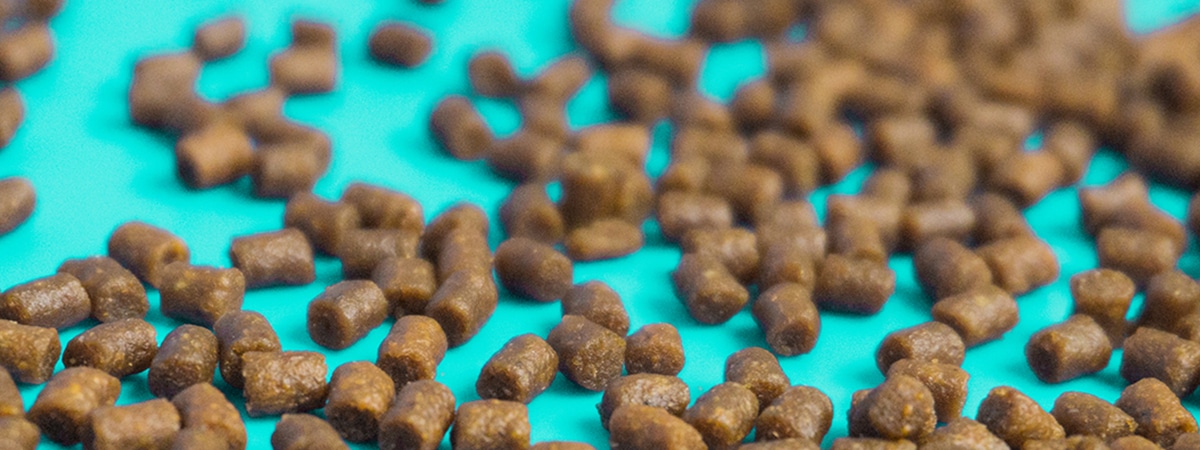Fish feed in Aquaculture

Many pet lovers and aquarists know that the same applies to animals: „You are what you eat“. Therefore, the food used in fish farming plays an important role in the end product that ends up on the consumer’s plate. In recent years, many negative headlines about harmful feed additives (e.g. ethoxyquin) and the unsustainable processing of wild-caught fish into fish meal and fish oil have dominated the press. But meanwhile, both manufacturers and users of fish feed are rethinking their approach to environmentally friendly alternatives. Thereby, we deal in this blog post with the questions, which food fish need at all, how you can pay attention to a balanced nutrition of the animals and how you can promote their health, well-being and growth.
First of all, the feed size is crucial in aquaculture. The smaller the fish, the smaller the pet food should be, so that the fish can absorb and process the food well. Therefore, the feed in fish farming is mainly fed as dry substance in the form of pellets or granules. These are filled in 25 kg sacks or in big bags (600 kg) and are then easy to handle during transport as well as good storable. To ensure a balanced diet for the fish, fish food contains vitamins and cereals. In addition, fish need a high proportion of protein in the feed to build muscle mass. Most edible fish are carnivorous animals. This means they need mainly animal proteins in their diet. Up to now, this has been ensured primarily by using fish meal and oil, which are obtained from catching and processing wild fish. Fishmeal has a very high protein content of around 60 percent. However, the sole use of fish meal and fish oil in feed production cannot be considered sustainable, especially since aquaculture has been the fastest growing branch of the global food industry since 1970. The more fish is to be produced, the more has theoretically be caught and processed into feed. This considerably reduces the wild stocks in the sea. Therefore, the goal is to increasingly develop sustainable feed and to replace the animal parts from endangered stocks with other components. But do you know that the fish you buy has been fed sustainably?
Environmentally friendly fish farms can be recognized by the german typical organic seals „Naturland“, „Bioland“, „ASC“ and others. These so-called sustainability certificates show the consumer that the obligations of social, environmental or sustainability standards have been met. For the fish feed this means strict control with regard to undesirable substances, raw materials from sustainable origin and from certified suppliers as well as fish meal and fish oil from safe and stable stocks. In the future, the use of fish meal and oil is to be further reduced by using alternative ingredients. Various feed manufacturers and research groups are investigating insects and various plants such as soy and rapeseed as potential protein sources in fish feed. The use of non-genetically manipulated food and the use of regional plants, which can considerably reduce transport distances, is of decisive importance. Likewise, slaughterhouse waste or waste from food processing is an alternative protein source for farmed fish. Another possibility is the complete switch of breeding to omnivorous fish. These species do not require a high proportion of animal protein and therefore have a smaller fish-in/fish-out ratio. This quotient indicates theoretically how many kilograms of fish must be used to gain one kilogram of fish biomass. While salmon needs about 3 kg, tuna needs a good 20 kg (!) of animal protein to achieve the same increase in mass.
The sea bass in our plant has a very good feed conversion rate. The feed coefficient is on average 1.3, which means that our fish only need to consume 1.3 kg of feed to grow 1 kg in biomass. Compared to other fish species, this balance can be considered as very positive and is supported by the use of high-quality feed and above all by our automation. A model based on our research work in the last years is stored in the automation. The model allows the control software in the SEAWATER Cube to optimize the growth of the fish. Thus, the sea bass grow from three to about 350 grams within one year.
It remains to be seen whether in the future it will be possible to completely produce fish feed without fish meal and fish oil, because ultimately these substances provide one of the reasons why we eat fish: healthy omega‑3 fatty acids. However, the latest research findings and technological developments suggest that the composition of fish feed can be made much more sustainable in the future.
Further informationen about the SEAWATER Cube
Check out more facts about our system and the technology.
References
— https://www.aller-aqua.com/de (called on 18th February 2019)
— mya: Interview: „Die Aquakultur steht zu Unrecht in der Kritik“. ONLINE Plus, 26.10.2015 (https://www.ernaehrungs-umschau.de/online-plus/26–10–2015-die-aquakultur-steht-zu-unrecht-in-der-kritik/407323/, called on 18th February 2019)
— „Die Zukunft der Fische – die Fischerei der Zukunft“ , maribus gGmbH, Hamburg, 2013 (https://worldoceanreview.com/wp-content/downloads/wor2/WOR2_Kapitel_4.pdf, called on 18th February 2019)
— „Wege zur schonenden Aquakultur“ (https://worldoceanreview.com/wor‑2/aquakultur/umweltbewusste-aquakultur/, called on 29th March 2019)
— Maximo: „Aquarium Fischfutter Vergleich: welches Fischfutter für dein Aquarium?“ (https://aquarium-fische-pflanzen.de/fischfutter-vergleich-welches-fischfutter-im-aquarium, called on 18th February 2019)
— Petra Schäfer: „Aquafarming“, ZEIT ONLINE, 27. Mai 2010 (https://www.zeit.de/2010/22/E‑Aquakultur-Fischfarm, aufgerufen am 19. Februar 2019)
— WWF: „Ist Aquakultur die Lösung?“, 17.September 2018 (https://www.wwf.de/themen-projekte/meere-kuesten/fischerei/nachhaltige-fischerei/aquakulturen/, called on 19th February 2019)
— Im Gespräch mit Prof. Dr. Ulfert Focken: „Futter für die Zuchtfische“ (https://www.thuenen.de/de/thema/weltshyernaehrung-und-globale-ressourcen/chancen-und-grenzen-der-aquakultur/futter-fuer-die-zuchtfische/, called on 19th February 2019)
— Nadja Podbregar: „Aquakultur: Insekten statt Fischmehl“, natur.de, 20. April 2017 (https://www.wissenschaft.de/umwelt-natur/aquakultur-insekten-statt-fischmehl/, called on 19th February 2019
— Udo Pollmer: „Was Fischkonsum wirklich gefährlich macht“, https://www.deutschlandfunkkultur.de/ethoxyquin-wuermer-co-was-fischkonsum-wirklich-gefaehrlich.993.de.html?dram:article_id=391080, called on 09th April 2019
— Nadja Ziebarth: Aquakultur – ja, aber bitteschön nur nachhaltig!“ https://www.bund.net/meere/belastungen/fischerei/aquakultur/,called on 09th April 2019
Image source
SEAWATER Cubes